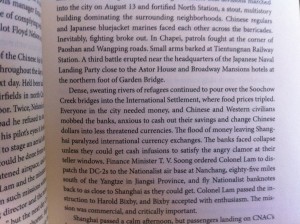Gregory Crouch's Blog, page 39
January 20, 2012
The Compressor Route chopped… more thoughts
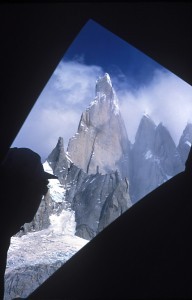
JJ Brooks eyeing Cerro Torre's SE Ridge
Having slept on it, I find myself more uncomfortable with the news that the upper sections of Maestri's Compressor Route were chopped by Hayden Kennedy and Jason Kruk as they descended after making the first "fair means" ascent of Cerro Torre's Southeast Ridge than I was last night, when I first heard the news and briefly posted about it.
First off, I'm a climber and a historian and I love Patagonia and I think I've got the chops to prove all those claims. I love the story of history — some of my first writings were the Goldline climbing stories that appeared in Rock & Ice in the mid-90s, and I've just finished writing a narrative non-fiction World War II flying story — ie, a history book — that I've been working on for the last eight YEARS.
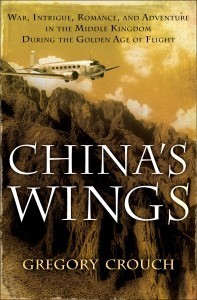 (It's called China's Wings, it'll go on sale on February 28, and one of the stories within is the best tale of mountain survival I've heard this side of Joe Simpson. Indeed, and somewhat amazingly considering the current circumstances, the genesis of the China's Wings idea came from my own adventures on the Compressor Route.)
(It's called China's Wings, it'll go on sale on February 28, and one of the stories within is the best tale of mountain survival I've heard this side of Joe Simpson. Indeed, and somewhat amazingly considering the current circumstances, the genesis of the China's Wings idea came from my own adventures on the Compressor Route.)
I think all climbers can agree that Maestri's Compressor Route is — or was — a world-renowned piece of climbing history, and I think all of us deplore the style and ethics of its first ascent.
However, I find myself lamenting its loss, and I'm hurt that members of my community have taken it away from me without even giving me an opportunity to voice my opinion about whether or not it should stand. Without giving ANY of the rest of us that opportunity.
That route was our common possession, and now it's gone. "The Compressor Route is no more," as Rolando Garibotti posted last night.
But should we flatten the Pyramids because they were built with slave labor, and we deplore slavery? Should we plow under Auschwitz because of the horrible deeds and philosophies perpetrated within its walls? Obviously not.
In my mind, a great piece of history has been taken from us, and we are the poorer for its loss.
If The Compressor Route was to be removed, it should have been removed only after a long period of open and public debate in which all of us were given the opportunity to voice our opinions — and perhaps to cast votes. The manner of its recent removal is patently undemocratic, and of that, I do not approve.
We should have been afforded the opportunity to make the decision as a community.

Cerro Torre casts a long shadow
Also, the last time I looked, Cerro Torre was entirely in Argentina. If such a massive change were to be made to such a famous route, on such a marvelous mountain, in such a wonderful country, surely the actual action should have been taken by the Argentine climbing community?
A mountain can certainly be desecrated, but I'm not sure one can be consecrated.
Cerro Torre's titanic indifference is what has always amazed me most.
January 19, 2012
The Compressor Route chopped!
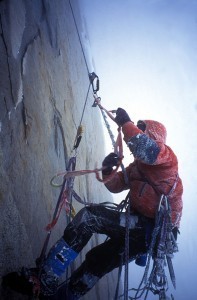
That's me jumaring on Cerro Torre's headwall in a storm in 1996 -- right through the section that has just been chopped
The Supertopo thread just posted by Rolando Garibotti (a friend I much admire and treasure), which clarifies the facts of Hayden Kennedy's and Jason Kruk's "fair means" ascent of Cerro Torre's Southeast Ridge. They did make the climb without using any of Maestri's bolts for progress, although they possibly might have used some of his belay bolts, and on the way down they "chopped" (ie, removed) the entire headwall, and at least one of the pitches below it. Rolo doesn't seem to have posted an update yet on his pataclimb.com website, although I'd imagine he soon will, and that will have additional information.
According to Rolo's initial post, "The Compressor Route is no more."
I've known for years Rolo has had it out for that route, since well before he published his American Alpine Journal article that so convincingly exposed Maestri's 1959 first ascent story as a complete hoax, but I confess to having mixed feelings about the chopping. I'm sure I can get used to the idea, and the mountain is certainly closer to its original state than it was a few days ago, but on the other hand, it's the end of an incredible story, and I think "the story" might be the thing I like most about climbing — whether mine or someone else's.
Standing on top of Maestri's Compressor is the most bizarre thing I've ever experienced, and I'm a little saddened that opportunity isn't in the world any longer.
(I'm actually fool enough to have been there twice.)
Climbing is such a fascinating theater of character.
CNAC wreckage in the Himalayas
Recently, I posted the news that the wreckage of CNAC #60 had been found in a remote corner of Yunnan Province. The plane, a C-47, went missing on November 17, 1942.
An article and three photographs about the discovery were published yesterday in the Winnetka Current.
January 18, 2012
China's Wings excerpt
An email this morning from Tracy Devine, my delightful and talented editor at Bantam, brought to my attention a China's Wings excerpt posted by Powell's Books. Here it is, Saint Patrick's Day, 1931, which is Chapter One, in its entirety. It's also here, on the Random House website, where the format is a little cleaner.
And allow me to tip my hat to Powell's Books. It's my favorite outing in Portland, Oregon, a veritable cathedral of civilization.
January 17, 2012
Huge news from Patagonia!
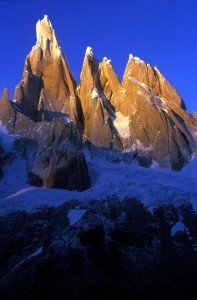
The Torres at sunrise
Breaking news from Patagonia, reported by Colin Haley, is that Hayden Kennedy and Jason Kruk have completed the first "fair means" ascent of Cerro Torre's SE Ridge (the left-hand skyline in the photo), not using any of Maestri's infamous bolts for progress or security. People have been trying to accomplish this feat for DECADES, so it's a tremendously significant ascent.
Here's the newsrelease at Alpinist, and here's what Colin Haley posted on Facebook:
"BIG NEWS: Although Jorge and I unfortunately fluffed this weather window, today we got to watch history being made through a Canon G12 zoom lens at Norwegos: Hayden Kennedy and Jason Kruk made the first fair-means ascent of the SE Ridge of Cerro Torre. Although I'm not 100% sure about the details, I think they took about 13 hours to the summit from a bivy at the shoulder, which is amazingly fast considering the terrain. The speed with which they navigated virgin ground on the upper headwall is certainly testament to Hayden's great skills on rock. Bravo! They might be in the mountains several more days (more good weather coming), but I'm sure we'll hear the details soon!"
January 15, 2012
CNAC and the Flying Tigers
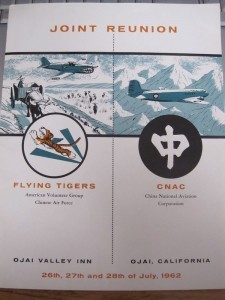
AVG & CNAC joint reunion booklet cover, 1962
CNAC and the Flying Tigers… and that's the American Volunteer Group, the real Flying Tigers, not just any old US Army Air Corps pilot who served in China during World War II.
(Ask any member of the AVG — they'll set you straight, and right quick).
CNAC was desperately short of pilots in the summer of 1942, just as it was expanding operations to prove that an airlift over the eastern Himalayas, the daunting "Hump," was possible. When Claire Chennault's AVG disbanded on July 4, 1942, 16 AVG pilots signed on with CNAC and flew the Hump for the remainder of the war.
For years after the war, the two organizations conducted joint annual reunions at the Ojai Valley Inn in Ojai, California… and if the stories are to be believed, they were outrageous bacchanalias.
Posted above is the cover of their 1962 reunion booklet.
Next, I'll explain why you're connecting to CNAC & the Hump every time you send a package via Fedex…
January 12, 2012
The Maiden flight of CNAC's Douglas Dolphin over Shanghai, 1934
Down at the bottom you'll find CNAC's first Douglas Dolphin on its maiden flight in 1934, but it's old Shanghai that makes this picture so enjoyable.
How many buildings can you identify?
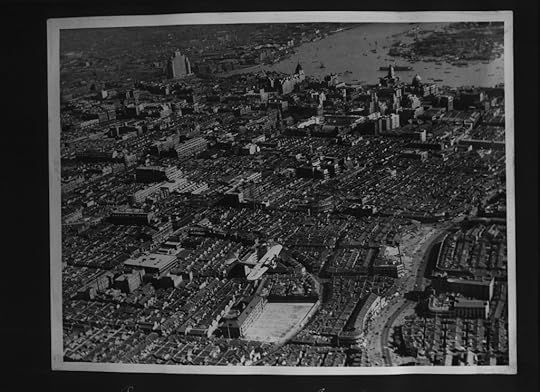
Photo by Edward P. Howard
January 11, 2012
CNAC wreckage found in Western China
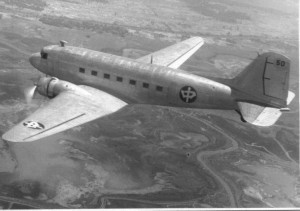
photo courtesy of Jim Dalby and cnac.org
Bob Willett, CNAC association member and author of An Airline at War: The Story of the China National Aviation Corporation and Its Men, and Clayton Kuhles of MIArecoveries.org, recently discovered the wreckage of the first CNAC airplane lost on the Hump — CNAC #60, a C-47 that went missing over western China on November 17, 1942.
Willett's cousin, James Brown, was copiloting CNAC #60 the day it went down.
Here are Willet and Kuhles featured in a brief MSNBC.com news spot.
January 10, 2012
Some of my best friends, and some more on Barbara Tuchman
Building on what I said yesterday about how Barbara Tuchman's book Practicing History helped me organize my research, through the years, I've read most of the major works in Barbara Tuchman's canon: The Guns of August, The Proud Tower, A Distant Mirror (in a Patagonian basecamp), and, of course, Stilwell and the American Experience in China. If my count is accurate, I've read Stilwell 4 times, once for a military history course on the China-Burma-India theater while I was a cadet at West Point, once before I wrote the China's Wings book proposal, a third time while I was writing it, and a fourth (and probably final time) after I finished my first complete draft. There are a few places where I find I don't agree with her analysis, most notably around the massive Battle of Shanghai fought in the last half of 1937, but in the main, I think she's spot on.

Some of my close friends... Dalleck on the right all the way to the official histories on the left (through Slim, Allen, Bayly & Harper, Tuchman, Sherwood, Speer, Shirer, Stimson, Morgantheau, the State Department, Morrison, Marshall, and Churchill). That's about a fifth of the books assembled for China's Wings.
For the record, Tuchman's Stilwell isn't the only book that received such massive attention during my writing. I cover-to-covered Charles F. Romanus's and Riley Sunderland's magisterial three-volume history of the CBI at least a half a dozen times. It was on my desk constantly through the writing of China's Wings Part IV. For the first sections of the book I was constantly checking facts and events in letters against Robert Dalleck's Franklin Delano Roosevelt and American Foreign Policy, 1932-1945, Jonathan Spence's Search for Modern China, and David M. Kennedy's Freedom from Fear: The American People in Depression and War, 1929-1945.) All three of which are superb books.
I'm excited, humbled, and more than a little trepidacious as I attempt to stand alongside such great books.
January 9, 2012
Practicing History, or, How Barbara Tuchman saved my bacon
Barbara Tuchman is one of the best writers of history. She's wonderful storyteller, I strongly recommend any of her books, and although she died in 1989 and I never had the opportunity to meet her, she seriously saved my bacon.
I threw myself into the research as soon as I sold the China's Wings proposal, reading and taking notes as widely as I could, and I quickly amassed a large quantity of material. Using a process I'd used to great effect prior to working on China's Wings, I stored every note in a file I titled "China's Wings: Raw Ideas," but that file quickly grew to hundreds of pages and thousands of bullets — way to large for my head to embrace, and without any practical means of sorting or grouping material. Progress ground to a halt as I groped for a way to gain control of my research that would allow me to both understand what I had and allow me to more forward.
I was saved, quite by accident, when I happened to read Barbara Tuchman's Practicing History. It's one of her few obscure books, published in 1981, but in one of its chapters she described her method of organizing research on index cards and I instantly recognized the utility of her system.
Subject went in the upper left corner of the card, source went in the upper right, and the factoid, quote, observation, or line went in the middle of the card. It proved the perfect system for managing my research, and my office and bedroom were soon a blizzard of 4×6 cards. I'd gather related cards into stacks several inches thick, pin them in binder clips, and from the stacks grew my chapters. As a bonus, the card stacks proved easily portable, so once I had assembled the research for a chapter, I could cart it off to a library, cafe, or bar to work. All of which helped.
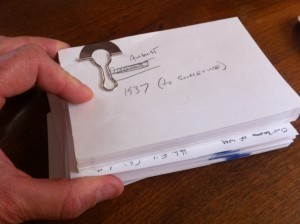 Here's the "August 1937 to source and use" card stack that became Chapter 8, "Things Fall Apart", about CNAC caught astride the outbreak of the Sino-Japanese War. The cards at the bottom whose top edges are marked in blue are the research morsels that I ended up using in the story. The unmarked ones on top are the tidbits that never found a home. They're about equal in volume.
Here's the "August 1937 to source and use" card stack that became Chapter 8, "Things Fall Apart", about CNAC caught astride the outbreak of the Sino-Japanese War. The cards at the bottom whose top edges are marked in blue are the research morsels that I ended up using in the story. The unmarked ones on top are the tidbits that never found a home. They're about equal in volume.
 Here are a few of the cards themselves. This one is from Emily "Mickey" Hahn's China to Me. And since my writing is next to indecipherable, sometimes even to me, that says, "Watching the war from rooftops, drinking cocktails." (I count myself the latest in the long line of men to fall in love with Mickey Hahn.)
Here are a few of the cards themselves. This one is from Emily "Mickey" Hahn's China to Me. And since my writing is next to indecipherable, sometimes even to me, that says, "Watching the war from rooftops, drinking cocktails." (I count myself the latest in the long line of men to fall in love with Mickey Hahn.)
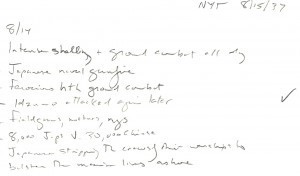 This one is sourced from the New York Times, describing the fighting on August 14. The bullet points describe intense shelling, ground combat all day; Japanese naval gunfire; ferocious hand to hand combat; Idzumo attacked again; field guns, mortars and naval gunfire support; 8,000 Japanese v. 30,000 Chinese; Japanese stripping the crews of their warships to bolster their marine units ashore.
This one is sourced from the New York Times, describing the fighting on August 14. The bullet points describe intense shelling, ground combat all day; Japanese naval gunfire; ferocious hand to hand combat; Idzumo attacked again; field guns, mortars and naval gunfire support; 8,000 Japanese v. 30,000 Chinese; Japanese stripping the crews of their warships to bolster their marine units ashore.
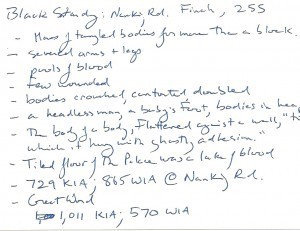 Percy Finch's book Shanghai and Beyond provided the data on this card, which was used (along with MANY others) to help describe the "Black Saturday" bombing at the corner of Nanking Road and the Bund. (Shanghai and Beyond is a good book, albeit an obscure one.)
Percy Finch's book Shanghai and Beyond provided the data on this card, which was used (along with MANY others) to help describe the "Black Saturday" bombing at the corner of Nanking Road and the Bund. (Shanghai and Beyond is a good book, albeit an obscure one.)
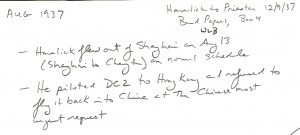 Here are described the actions of CNAC pilot Frank Havelick, taken from a letter to Andre Priester, the text of which was provided to me by Nancy Allison Wright. The DC-2 on this card became the "Hong Kong DC-2″, a massive bone of contention between Pan Am and CNAC's Chinese leadership in August, September, and October of 1937.
Here are described the actions of CNAC pilot Frank Havelick, taken from a letter to Andre Priester, the text of which was provided to me by Nancy Allison Wright. The DC-2 on this card became the "Hong Kong DC-2″, a massive bone of contention between Pan Am and CNAC's Chinese leadership in August, September, and October of 1937.
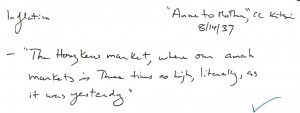 This information about inflation in Shanghai caused by the outbreak of war comes from a letter "Anna to Mother, CC Kitsi [Bond]", 8/14/1937, in the William Langhorne Bond collection at the Hoover Institute Archive.
This information about inflation in Shanghai caused by the outbreak of war comes from a letter "Anna to Mother, CC Kitsi [Bond]", 8/14/1937, in the William Langhorne Bond collection at the Hoover Institute Archive.
The line "food prices tripled" in the center of the page photographed below is the line created from the "Anna to Mother, CC Kitsi" card, and I confirmed the fact in one of my interviews with Moon Chin. (Or so says my endnotes…)
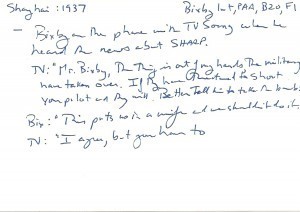 And here to the right we have a conversation from an interview conducted with Harold Bixby that found its way into the Pan Am Archive at the University of Miami. That's Bixby and TV Soong arguing about the militarization of CNAC by the Chinese Air Force.
And here to the right we have a conversation from an interview conducted with Harold Bixby that found its way into the Pan Am Archive at the University of Miami. That's Bixby and TV Soong arguing about the militarization of CNAC by the Chinese Air Force.
Those factoids — from books, newspapers, letters, and interviews — are among the many dozens that went into the creation of pages 93 to 97.
And that was how the sausage got made, bit by painful bit.


